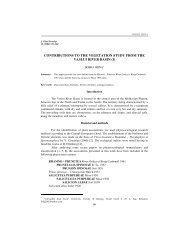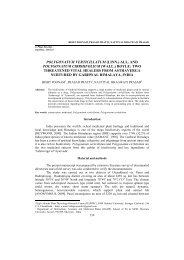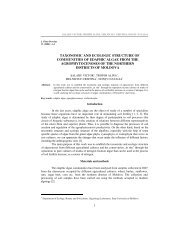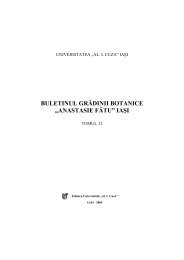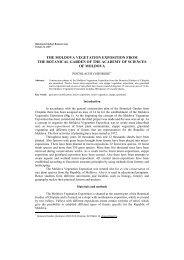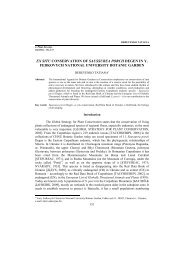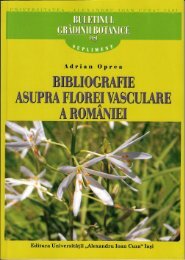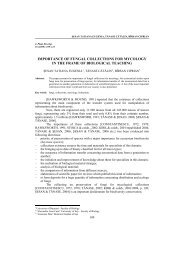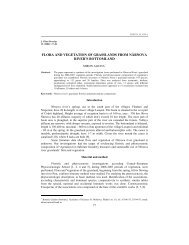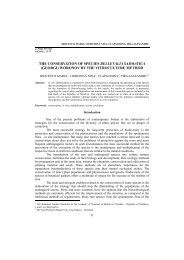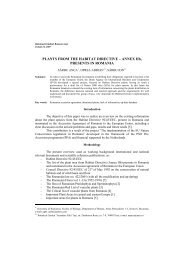trichoderma viride pers. - Journal of Plant Development
trichoderma viride pers. - Journal of Plant Development
trichoderma viride pers. - Journal of Plant Development
You also want an ePaper? Increase the reach of your titles
YUMPU automatically turns print PDFs into web optimized ePapers that Google loves.
ŞESAN TATIANA EUGENIA , OANCEA FLORIN<br />
J. <strong>Plant</strong> Develop.<br />
17 (2010): 49-62<br />
TRICHODERMA VIRIDE PERS. – EXPERIMENTAL MODEL FOR<br />
BIOLOGICAL AND BIOTECHNOLOGICAL INVESTIGATIONS<br />
OF MYCROMYCETA WITH IMPORTANCE IN OBTAINING<br />
PLANT PROTECTION BIOPRODUCTS<br />
ŞESAN TATIANA EUGENIA 1 , OANCEA FLORIN 2<br />
Abstract:<br />
The technological process for obtaining plant protection bioproducts contains 2 main phases: (i)<br />
biomass biosynthesis <strong>of</strong> microorganisms in a culture medium, available for industrialization and (ii)<br />
biomass conditioning <strong>of</strong> microorganism, the antagonistic micromycetes, respectively. For this type <strong>of</strong><br />
activities it is essential to establish biological development parameters: (i) the optimum composition<br />
<strong>of</strong> the liquid culture medium for development <strong>of</strong> the fungus under aerobiotic conditions and (ii) the<br />
optimal parameters <strong>of</strong> biosynthesis in the studied medium. The biomass biosynthesis technology is<br />
discontinuous, <strong>of</strong> cascade type, and develops several phases: (1) preparing <strong>of</strong> the laboratory<br />
inoculum, (2) preparing <strong>of</strong> the fungal pure culture in Erlenmeyer bottles, (3) industrial (simulated)<br />
multiplication in the aired and agitated liquid medium.<br />
This paper presents some experimental aspects referring to: 1 – Characterization <strong>of</strong> the biologically<br />
active T. <strong>viride</strong> isolates, establishing and verifying <strong>of</strong> their biological thresholds; 2 – Evaluation and<br />
experimental verifying <strong>of</strong> the mass multiplication ability <strong>of</strong> antagonistic T. <strong>viride</strong> fungi on the culture<br />
media in order to select the optimum industrial culture substrate (medium); 3 – Biochimical<br />
characterization <strong>of</strong> T. <strong>viride</strong> isolates by electrophoretic analysis <strong>of</strong> their protein pr<strong>of</strong>ile; 4 –<br />
Evaluation <strong>of</strong> the T. <strong>viride</strong> biological activity <strong>of</strong> T. <strong>viride</strong> isolates against phytopathogenic fungi with<br />
high practical importance: Fusarium graminearum Schwabe (T. Gibberella zeae (Schwein.) Petch),<br />
F. culmorum (W. G. Sm.) Sacc., Pythium ultimum Trow, Botrytis cinerea Pers., Sclerotinia<br />
sclerotiorum (Lib.) de Bary, Alternaria spp. [A. alternata (Fr.) Keissl., Alternaria radicina Meier,<br />
Drechsler and E. D. Eddy (Stemphylium radicinum (Meier, Drechsler and E. D. Eddy) Neerg.)] etc.; 5<br />
– Processing <strong>of</strong> technological scheme for obtaining plant protection preparates based on biologically<br />
active isolates <strong>of</strong> T. <strong>viride</strong>.<br />
Key words: antagonistic micromycetes, Trichoderma <strong>viride</strong>, electrophoretic analysis, plant protection bioproducts<br />
Introduction<br />
Trichoderma <strong>viride</strong> Pers., Neues Mag. Bot. 1: 92 (1794), syn. T. lignorum (Tode)<br />
Harz, Linig. Hyph. 29 (1871) belonging to Hypocreaceae Family, Hypocreales Order,<br />
Hypocreomycetidae Subclass, Sordariomycetes Class, Ascomycota Phyllum, Regnum Fungi<br />
[15, 16, 36], is one <strong>of</strong> the most studied as a fungus with importance in biotechnology [2, 7,<br />
10, 17, 18, 19, 20, 21, 26, 28, 29, 30, 31, 34, 35 a.o.]. It is an appropriate experimental<br />
model <strong>of</strong> mycoparasitic fungus for obtaining bioproducts with plant protection importance<br />
[4, 6, 9, 11, 14].<br />
The aim <strong>of</strong> this paper was the development <strong>of</strong> the technology for obtaining plant<br />
protection bioproducts based on T. <strong>viride</strong> as an experimental model for the autochtonous<br />
biotechnology.<br />
1 Department <strong>of</strong> Botany & Microbiology, Biology Faculty, University <strong>of</strong> Bucharest, Aleea Portocalilor, nr. 1-3,<br />
sector 6, RO-060101Bucureşti 35; e-mail: tatianasesan@yahoo.com<br />
2<br />
Research-<strong>Development</strong> Institute for <strong>Plant</strong> Protection Bucharest, Academy <strong>of</strong> Agricultural Sciences and Forestry,<br />
Bdul Ion Ionescu de la Brad, nr. 8, sector 1, 013811 Bucureşti 18<br />
49
TRICHODERMA VIRIDE PERS. – EXPERIMENTAL MODEL FOR BIOLOGICAL AND …<br />
The objectives <strong>of</strong> the research were the following: 1 – Characterization <strong>of</strong> the<br />
biologically active T. <strong>viride</strong> isolates, establishing and verifying <strong>of</strong> their biological<br />
thresholds; 2 – Evaluation and experimental verifying <strong>of</strong> the mass multiplication ability <strong>of</strong><br />
antagonistic T. <strong>viride</strong> fungi on the culture media in order to select the optimum industrial<br />
culture substrate (medium); 3 – Biochemical characterization <strong>of</strong> T. <strong>viride</strong> isolates by<br />
electrophoretic analysis <strong>of</strong> their protein pr<strong>of</strong>ile; 4 – Evaluation <strong>of</strong> the biological activity <strong>of</strong><br />
T. <strong>viride</strong> isolates against phytopathogenic fungi with high practical importance; 5 –<br />
Processing <strong>of</strong> technological phases for obtaining plant protection products based on<br />
biologically active isolates <strong>of</strong> T. <strong>viride</strong>.<br />
Material and methods<br />
As biological material there were used 5 isolates <strong>of</strong> T. <strong>viride</strong> (Td 5 , Td 35 , Td 45 ,<br />
Td 49 ,Td 50 ) and isolates <strong>of</strong> the following 8 phytopathogenic fungi: Fusarium graminearum<br />
Schwabe (T. Gibberella zeae (Schwein.) Petch), F. culmorum (W. G. Sm.) Sacc., Pythium<br />
ultimum Trow, Botrytis cinerea Pers., Sclerotinia sclerotiorum (Lib.) de Bary, Alternaria<br />
spp. [A. alternata (Fr.) Keissl., Alternaria radicina Meier, Drechsler and E. D. Eddy<br />
(Stemphylium radicinum (Meier, Drechsler and E. D. Eddy) Neerg.), all cultures obtained,<br />
isolated and preserved by the first author.<br />
1. For the characterization <strong>of</strong> the biologically active T. <strong>viride</strong> isolates, 7<br />
different solid culture media (Fig. 1), 17 sources <strong>of</strong> carbon (Fig. 2) and 18 <strong>of</strong> nitrogen<br />
(Figs. 3-4), 16 initial pH values <strong>of</strong> culture media (Fig. 5), 19 temperatures have been<br />
performed (Fig.6).<br />
Fungal growth have been evaluated by measuring the colony diameter (3-5<br />
replicates/variant) every day and using for graphs the data after 2 and 6 days. The last day <strong>of</strong><br />
experiment, the 6 th day, was the day when the T. <strong>viride</strong> colony covered the whole surface <strong>of</strong> the<br />
Petri plate <strong>of</strong> 10 cm diameter. The sporulation <strong>of</strong> tested fungus was appreciated by<br />
macroscopical analysis following the microscopical analysis [3, 22, 23, 24, 26, 27, 28, 29, 31].<br />
2. For selecting the optimum submerged culture medium, there were tested 9<br />
media containing intermediate products or residual ones from the food industry (Fig. 7) and<br />
and 4 liquid media (a-d) (tables 1-3) [25, 26, 27, 28, 29, 31].<br />
3. For the biochemical characterization <strong>of</strong> T. <strong>viride</strong> isolates the SDS-PAGE<br />
analysis was used to reveal protein bands and to determine protein molecular mass.<br />
Investigations have been performed by Laemmli vertical method, in MINI-PROTEAN II<br />
(BIO-RAD), using poliacrylamide gel as a migration substrate [5].<br />
4. For the appreciation <strong>of</strong> biological activity <strong>of</strong> T. <strong>viride</strong> isolates it was used the<br />
method <strong>of</strong> dual cultures [12]. Evaluation <strong>of</strong> antagonistic activity <strong>of</strong> T. <strong>viride</strong> isolates has<br />
been done by calculating <strong>of</strong> x coefficient from the ratio between inner radius (i) and outer<br />
radius (e) <strong>of</strong> the phytopathogenic test-fungi (A) and the antagonistic ones (B) (T. <strong>viride</strong>),<br />
after the formula X = iA/iB x eB/eA. When x=1, there is no influence between two fungi;<br />
when x1, the tested isolate prove no antagonism [31].<br />
5. Biotechnological parameters for production <strong>of</strong> the bioproducts based on T.<br />
<strong>viride</strong> strain was followed according to the general literature for microbial plant protection<br />
products’ biosynthesis and formulation [8, 13, 14, 18, 21, 32, 33].<br />
50
ŞESAN TATIANA EUGENIA , OANCEA FLORIN<br />
Results and discussion<br />
1 – Characterization <strong>of</strong> the biologically active T. <strong>viride</strong> isolates, establishing<br />
and verifying <strong>of</strong> their biological thresholds.<br />
1.1. <strong>Development</strong> <strong>of</strong> T. <strong>viride</strong> on different solid media. Among the 6 tested solid<br />
culture media, the most favourables for the development (growth and sporulation) <strong>of</strong> T.<br />
<strong>viride</strong>, isolate Td 50 , were: Weindling, Warcup, Malt agar extract and PDA (Fig. 1). The<br />
diameter <strong>of</strong> fungal colony have had values between 2.82-5.2 cm, after 2 days, and between<br />
8.54-9.0 cm, after 6 days, respectivelly. On these media the fungal sporulation was<br />
excellent.<br />
10<br />
9<br />
8<br />
7<br />
6<br />
5<br />
4<br />
3<br />
2<br />
1<br />
0<br />
2 days<br />
6 days<br />
CONTROL<br />
Weindling<br />
Warcup<br />
Czapek-Dox<br />
Czapek<br />
Malt extract<br />
PDA<br />
Fig. 1. Growth <strong>of</strong> Trichoderma <strong>viride</strong>, isolate Td 50 , on different solid culture media,<br />
evaluated by the diameter <strong>of</strong> fungal colony<br />
1.2. <strong>Development</strong> <strong>of</strong> T. <strong>viride</strong> on solid Weindling medium (WG) with different<br />
carbon sources. (Fig. 2). Among monosaccharides, the most favourable for growth and<br />
sporulation <strong>of</strong> T. <strong>viride</strong> were: mannite, fructose (levulose), D-ribose, D-galactose, D-<br />
mannose, D-dextrose (glucose), the fungal colony having between 4.8-5.833 cm in<br />
diameter, after 2 days, and 9.0 cm, after 6 days. Sporulation <strong>of</strong> T. <strong>viride</strong> was abundant on<br />
medium variants containing the mentioned monosaccharides. The poorest development <strong>of</strong><br />
fungus was found on the medium with D-sorbitol/sorbite, fungal colony having 2.333 cm<br />
diameter after 2 days and only 4.433 cm after 6 days.<br />
10<br />
8<br />
6<br />
4<br />
2<br />
0<br />
2 days<br />
6 days<br />
glucose (Dmanite<br />
fructose/lev<br />
D-sorbitol<br />
arabinose<br />
saccharose<br />
celobiose<br />
melibiose<br />
cellulose<br />
inuline<br />
glycerine<br />
Fig. 2. Growth <strong>of</strong> Trichoderma <strong>viride</strong>, isolate Td 50 , on solid culture Weindling medium<br />
(WG) containing different carbon sources, evaluated by the diameter <strong>of</strong> fungal colony<br />
51
TRICHODERMA VIRIDE PERS. – EXPERIMENTAL MODEL FOR BIOLOGICAL AND …<br />
Among disaccharides, the most suitable for the T. <strong>viride</strong> development were<br />
melibiose and maltose (diameter <strong>of</strong> colonies between 5.057 and 5.733 cm after 2 days, and<br />
9.0 cm after 6 days, respectively), followed by lactose and celobiose (diameter between<br />
3.833 and 3.933 cm, after 2 days, and 9.0 cm after 6 days). The most inadequate for the<br />
fungal development was saccharose, with the values <strong>of</strong> 1.2 cm diameter, after 2 days and<br />
1.533 cm, after 6 days.<br />
In the group <strong>of</strong> polysaccharides, the most favourable was cellulose (5.067 cm<br />
diameter after 2 days), followed by starch and inuline (3.633-4.567 cm diameter after 2<br />
days and 9.0 cm after 6 days). The lowest development <strong>of</strong> T. <strong>viride</strong> has been performed on<br />
the medium containing glycerine, fungal colony measuring only 1.4 cm diameter after 2<br />
days and 2.3 cm after 6 days).<br />
1.3. <strong>Development</strong> <strong>of</strong> T. <strong>viride</strong> on solid Weindling medium (WG) with different<br />
nitrogen sources. The cultivation <strong>of</strong> T. <strong>viride</strong> on Czapek medium containing different<br />
sources <strong>of</strong> organic and mineral nitrogen (Figs. 3-4) showed that peptone and the aminoacids<br />
DL-leucine, L-cystine, DL-citruline, DL-nor-leucine were the most favourable for fungal<br />
development (Fig. 3).<br />
2 days 6 days<br />
10<br />
8<br />
6<br />
4<br />
2<br />
0<br />
CONTROL<br />
peptone<br />
glycocol<br />
L-leucine<br />
DL-leucine<br />
DL-nor-leucine<br />
tirosine<br />
D-serine<br />
lisine<br />
triptophane<br />
L-cistine<br />
DL-citruline<br />
L-arginine<br />
Fig. 3. Growth <strong>of</strong> Trichoderma <strong>viride</strong>, isolate Td 50 , on solid Weindling culture medium containing<br />
different nitrogen sources (aminoacids), evaluated by the diameter <strong>of</strong> fungal colony<br />
10<br />
9<br />
8<br />
7<br />
6<br />
5<br />
4<br />
3<br />
2<br />
1<br />
0<br />
CONTROL<br />
DL-asparagine<br />
urea<br />
rib<strong>of</strong>lavine<br />
2 days<br />
6 days<br />
kallium nitrate<br />
sodium nitrate<br />
ammonium nitrate<br />
calcium nitrate<br />
ammonium tartrate<br />
monopotasic ammonium phosphate<br />
ammonium sulphate<br />
ammonium carbonate<br />
ammonium nitrate<br />
Fig. 4. Growth <strong>of</strong> Trichoderma <strong>viride</strong>, isolate Td 50 , on solid culture Weindling medium containing<br />
different nitrogen sources (salts, amides, vitamins), evaluated by the diameter <strong>of</strong> fungal colony<br />
52
ŞESAN TATIANA EUGENIA , OANCEA FLORIN<br />
Fungal sporulation was very good on media with: peptone, lysine, tryptophan, DLasparagine,<br />
urea and ammonium salts, and good on media with glycocol, tyrosine, DLcitruline<br />
and rib<strong>of</strong>lavin.<br />
1.4. <strong>Development</strong> <strong>of</strong> T. <strong>viride</strong> on solid Weindling medium (WG) with different<br />
initial values <strong>of</strong> pH. The best growth <strong>of</strong> the T. <strong>viride</strong> colonies was recorded in acid<br />
medium (pH 4.0-5.5), with a diameter <strong>of</strong> 6.32 until 7.66 cm after 2 days and 9.0 after 6<br />
days and the poorest one in highly alkaline medium with pH 13.0, and the diameter <strong>of</strong> the<br />
T. <strong>viride</strong> colony <strong>of</strong> 3.24 cm after 2 days and 5.42 cm after 6 days (Fig. 5).<br />
2 days 6 days<br />
10<br />
8<br />
6<br />
4<br />
2<br />
0<br />
3 4 4,5 5 5,5 6 7 7,5 8 8,5 9 10 11 12 13 14<br />
Fig. 5. Growth <strong>of</strong> Trichoderma <strong>viride</strong>, isolate Td 50 , on solid Weindling culture medium with different<br />
initial values <strong>of</strong> pH, evaluated by the diameter <strong>of</strong> fungal colony.<br />
The sporulation <strong>of</strong> T. <strong>viride</strong> was highest on acid medium, and the poorest on<br />
highly alkaline medium (pH 9.0-13.0).<br />
1.5. <strong>Development</strong> <strong>of</strong> T. <strong>viride</strong> on solid Weindling (WG) medium under the<br />
different temperatures. The optimum growth and sporulation <strong>of</strong> T. <strong>viride</strong> was the range<br />
between 24 and 32ºC (Fig. 6).<br />
10<br />
8<br />
6<br />
4<br />
2<br />
0<br />
26<br />
37<br />
35<br />
34<br />
32<br />
30<br />
28<br />
26<br />
24<br />
22<br />
20<br />
18<br />
16<br />
14<br />
12<br />
10<br />
8<br />
6<br />
4<br />
2<br />
Fig. 6. Growth <strong>of</strong> Trichoderma <strong>viride</strong>, isolate Td 50 , on solid Weindling culture medium at different<br />
values <strong>of</strong> temperature, evaluated by the diameter <strong>of</strong> fungal colony, after 2 days.<br />
The temperatures ranging between 2 and 12ºC do not allow fungal growth and<br />
sporulation, between 14 and 18ºC growth but not sporulation was promoted, whereas<br />
53
TRICHODERMA VIRIDE PERS. – EXPERIMENTAL MODEL FOR BIOLOGICAL AND …<br />
between 20-22ºC both growth and sporulation were favoured. At 37ºC the growth and<br />
sporulation <strong>of</strong> the T. <strong>viride</strong>, isolate Td 50 , were very well.<br />
Based on these investigations, it was possible to be established the optimal<br />
biological parameters for the development <strong>of</strong> T. <strong>viride</strong>, isolate Td 50 : (i) solid culture media:<br />
Weindling, Warcup, Malt extract agar, PDA; (ii) carbon sources: monosaccharides mannite,<br />
fructose, ribose, glucose, manose; (iii) nitrogen sources: peptone, aminoacids DL-leucine,<br />
L-cistine, DL-citruline, DL-nor-leucine, ammonium nitrate and tartrates salts; (iv) pH initial<br />
values <strong>of</strong> culture media: 4.0-5.5 (for growth), 4.0-8.5 (for biomass); (v) temperatures:<br />
optimum 26ºC, for growth 24-32ºC, for sporulation 20-22ºC.<br />
2 – Evaluation and experimental verifying <strong>of</strong> the mass multiplication ability<br />
<strong>of</strong> antagonistic T. <strong>viride</strong> fungi on the culture media in order to select the optimum<br />
industrial culture substrate (medium).<br />
In the submerged cultivation <strong>of</strong> T. <strong>viride</strong> on nine liquid media, some <strong>of</strong> which<br />
contained intermediate products from the food commodity industry, the best growth was<br />
obtained on beer must (mB), on the Weindling medium with the imported chemically pure<br />
glucose (WG) or with indigenous food glucose (Wg) and on the MPB medium (Fig. 7.).<br />
100<br />
80<br />
60<br />
40<br />
20<br />
0<br />
PDA200<br />
PDA500<br />
C+M<br />
P<br />
mB<br />
MP<br />
MBP<br />
Wg<br />
WG<br />
(CONTROL)<br />
Nutrients g d.s. Biomass g d.s. Efficiency %<br />
Fig. 7. Accumulation <strong>of</strong> biomass (g. dry substance/ d.s.) and efficiency (%) <strong>of</strong> culture liquid media by<br />
Trichoderma <strong>viride</strong>, isolate Td 50<br />
On these media the sporulation and the titre <strong>of</strong> conidia and chlamidospores were<br />
high. The highest quantity <strong>of</strong> dry biomass was obtained and a better use (70.0-84.863%) <strong>of</strong><br />
the nutrients from the medium was recorded. Data <strong>of</strong> optic density <strong>of</strong> the T. <strong>viride</strong> liquid<br />
cultures confirm this (Fig. 8.).<br />
3000<br />
0 hrs. 96 hrs.<br />
2500<br />
2000<br />
1500<br />
1000<br />
500<br />
0<br />
Td50/<br />
PDA200<br />
Td50/<br />
PDA500<br />
Td50/ C+M Td50/ P Td50/ mB Td50/ MP Td50/ MBP Td50/ Wg Td50/ WG<br />
(CONTROL)<br />
Fig. 8. Optic density <strong>of</strong> Trichoderma <strong>viride</strong>, isolate Td 50 , cultivated on different liquid agitated media<br />
54
ŞESAN TATIANA EUGENIA , OANCEA FLORIN<br />
Biomass accumulation in the cultures grown in liquid Weindling medium with<br />
different initial pH was the highest at pH 4.5-5.5 and the lowest in alkaline (pH 7.5-13.0)<br />
and highly acid (pH1.0-2.0) media (Fig. 9.).<br />
16<br />
14<br />
12<br />
10<br />
8<br />
6<br />
4<br />
2<br />
0<br />
CONTROL (6.4)<br />
13<br />
12<br />
11<br />
10<br />
9<br />
8.5<br />
8<br />
7.5<br />
7<br />
6<br />
5.5<br />
5<br />
4.5<br />
4<br />
3<br />
2<br />
1<br />
Fig. 9. Trichoderma <strong>viride</strong> biomass (cg) accumulated in Weindling medium with different pH values,<br />
after 21 days<br />
A Weindling medium with initial pH between 4.0 and 6.4 and an inoculum rich in<br />
conidia (1x10 8 – 1x10 5 conidia/ml) which ensure a fast development <strong>of</strong> both conidia and<br />
chlamidospores in the culture are most favourable for the submerged cultivation <strong>of</strong> T.<br />
<strong>viride</strong>. Based on these investigations we can favour the obtaining <strong>of</strong> a mixed biological<br />
product <strong>of</strong> phytosanitary utilization containing also conidia and chlamidospores besides<br />
mycelium <strong>of</strong> T. <strong>viride</strong> by maintaining the appropriate cultivation parameters.<br />
From the experiements on submerged cultivation 72 and 96 houres, we have<br />
obtained superior results on conidia an chlamidospores titre in the variant <strong>of</strong> 96 houres <strong>of</strong><br />
cultivation and at the temperatures between 24 – 30 o C.<br />
For the checking <strong>of</strong> fungal cultivation on the liquid aired medium and aerated with<br />
carriers (simulation <strong>of</strong> industrial process) 4 variant <strong>of</strong> media have been performed (table 1),<br />
the evaluation being based on the efficacy <strong>of</strong> producing biomass.<br />
Tab. 1. Efficacy expressed by biomass <strong>of</strong> Trichoderma <strong>viride</strong>, isolate Td 50 ,<br />
obtained in different tested liquid media**<br />
Culture media Wet biomass (g/l) Dry biomass (g/l)<br />
medium variant a) 9.82 ± 0.54 10.75 ± 0.54<br />
medium variant b) 10.75 ± 1.41 4.04 ± 0.43<br />
medium variant c) 8.64 ± 1.16 2.86 ± 0.37<br />
mediumvariant d) 12.53 ± 0.95 4.88 ± 0.32<br />
* average <strong>of</strong> least 3 determinations; ** the composition <strong>of</strong> culture media a), b), c), d) are under the<br />
process <strong>of</strong> a patent<br />
The best results have been performed on the medium with the formula no. 4<br />
(medium d), which is, also, very appropriate being a medium with a low content <strong>of</strong><br />
ingredients.<br />
These results are in accord with our previous results which mentioned glucose as<br />
an optimum carbon source for T. <strong>viride</strong> cultivation [1, 3].<br />
The yeast extract from the medium composition/formula is essential, in general,<br />
for the cultivation <strong>of</strong> microorganisms. This ingredient <strong>of</strong>fers some growing factors, like<br />
vitamins and aminoacids, as well as some organic nitrogen compounds with high<br />
55
TRICHODERMA VIRIDE PERS. – EXPERIMENTAL MODEL FOR BIOLOGICAL AND …<br />
bioavailability. Yeast extract is the ingredient which ensure high efficacy in obtaining <strong>of</strong> T.<br />
<strong>viride</strong> biomass.<br />
In the table 2 there were results presenting the influence <strong>of</strong> temperature on the<br />
fungal growth in the medium d) in bioreactor.<br />
Tab. 2. The influence <strong>of</strong> temperature on the growth <strong>of</strong> Trichoderma <strong>viride</strong>, isolate<br />
Td 50 , in aired and agitated medium d), evaluated by fungal biomass<br />
Temperature ( o C) Wet biomass * (g/l) Dry biomasa * (g/l)<br />
22.5 11.47 ± 1.04 4.12 ± 0.39<br />
25.0 12.72 ± 1.66 4.87 ± 0.61<br />
27.5 11.35 ± 0.87 3.39 ± 0.27<br />
30.0 10.75 ± 1.42 3.42 ± 0.46<br />
* average <strong>of</strong> least 3 determinations<br />
The results showed that T. <strong>viride</strong> is a mesophylous to cryophylous fungus, having<br />
the optimum temperature for development at 25 o C. These data are in accord with the<br />
literature [25].<br />
The effect <strong>of</strong> aeration on the biosynthesis efficacy <strong>of</strong> T. <strong>viride</strong> has been performed<br />
in the same medium d) and the data are presented in the Tab. 3.<br />
Tab. 3. The effect <strong>of</strong> airation on the the biosynthesis efficacy <strong>of</strong> Trichoderma <strong>viride</strong>, isolate<br />
Td 50 , in aired and agitated medium d), evaluated by fungal biomass<br />
Airation rate<br />
(l air/l medium/minute)<br />
Wet biomass*<br />
(g/l)<br />
Dry biomass*<br />
(g/l)<br />
0.50 10.23 ± 1.37 3.42 ± 0.42<br />
0.75 11.35 ± 1.08 3.94 ± 0.37<br />
1.00 12.41 ± 1.67 4.42 ± 0.54<br />
1.25 12.67 ± 1.22 4.58 ± 0.48<br />
1.50 11.88 ± 1.16 3.87 ± 0.35<br />
* average <strong>of</strong> least 3 determinations<br />
Our results show that a high rate <strong>of</strong> aeration did not significantly promote the<br />
biomass accumulation in the liquid media tested. The optimal rates <strong>of</strong> aeration are between<br />
0.75 and 1.25 l air/l medium /minute, results which are in accord with similar data from the<br />
biosynthesis literature. Based on these results, in practice is recommended the minimal rate<br />
<strong>of</strong> aeration (0.75 l air/l medium/minute), which ensure the efficiency <strong>of</strong> biosynthesis, due to<br />
energy consumption reduction.<br />
For the manufacturing <strong>of</strong> plant protection bioproducts have been selected strain<br />
Td 49 and Td 50 <strong>of</strong> Trichoderma <strong>viride</strong>. On the investigated parameters these strains shown<br />
equilibrated characteristics, combining high biological activity with rapid production <strong>of</strong><br />
biomass on liquid medium (aerated, with carriers) and good survival during the formulation<br />
process. These strains were deposited for patent purposes on NCAIM (international<br />
depositary authority) and the patent applications were submitted to OSIM.<br />
In conclusion, the parameters for submerged cultivation <strong>of</strong> Trichoderma <strong>viride</strong> are<br />
presented in the Tab. 4.<br />
56
ŞESAN TATIANA EUGENIA , OANCEA FLORIN<br />
Tab. 4. Parameters <strong>of</strong> submerged cultivation <strong>of</strong> the fungus Trichoderma <strong>viride</strong><br />
Parameters<br />
Values<br />
Weindling culture medium<br />
variant Wg (indigenous food glucose)<br />
Time <strong>of</strong> cultivation<br />
4 days (96 houres)<br />
Temperature <strong>of</strong> culture medium<br />
Optimum temperature<br />
24 – 30 0 C<br />
24 – 28 0 C<br />
Reaction <strong>of</strong> culture medium (pH) Acid until low acid (pH 4.0 – 6.4)<br />
Titre <strong>of</strong> inoculum<br />
1x10 5 – 1x10 8 conidia/ml medium<br />
Optimal airation<br />
Viability <strong>of</strong> biomass<br />
0.75-1.25 l air/l medium/ minute<br />
6-7 monthes<br />
3 – Biochemical characterization <strong>of</strong> T. <strong>viride</strong> isolates by electrophoretic<br />
analysis <strong>of</strong> their protein pr<strong>of</strong>ile (Tab. 5) reveled that:<br />
3.1. Proteins with MM 7, 8, 10, 12, 14, 35, 56, 60 kD represent characteristics for<br />
genus and species, being well differentiated;<br />
3.2. Within the same species the quantitative differences appeared at the level <strong>of</strong><br />
proteins with MM <strong>of</strong> 29, 45, 87, 89 kD and are determinated by provenance <strong>of</strong> various<br />
isolates belonging to the same species;<br />
3.3. Isolates Td49 and Td50 proved strong similarities having a common<br />
provenance; both isolates proved a high antagonistic capacity against the test-pathogens<br />
studied.<br />
Tab. 5 Biochemical characterization <strong>of</strong> some Trichoderma <strong>viride</strong> isolates based on<br />
protein bands separated z<br />
MM/kD 7 8 10 12 14 29 35 45 56 60 89 97<br />
Rf 0.98 0.93 0.89 0.84 0.78 0.55 0.49 0.44 0.33 0.31 0.18 0.<br />
15<br />
Td 35 ++ + + ++ ++ - ++ - + + - -<br />
Td 45 ++ ++ ± ++ ++ ± ± ± + ± ± ±<br />
Td 49 ++ ++ ++ ++ ++ ± ++ + + ++ ++ ++<br />
Td 50 ++ ++ ++ ++ ++ ± ++ + + ++ ± ±<br />
Td 5 (ctr) + ++ ++ ++ ++ - + - + + - -<br />
z = band intensity; ‘-‘ = no band; ‘±‘ = weak band; ‘+‘ = intense band;<br />
‘++‘ = very intense band; ctr = control<br />
These results are the first step in a future research conducted to obtain a molecular<br />
characterization <strong>of</strong> our T. <strong>viride</strong> collection <strong>of</strong> isolates selected as biological control agents<br />
<strong>of</strong> some practically important plant pathogens.<br />
4 – Evaluation <strong>of</strong> the biological activity <strong>of</strong> T. <strong>viride</strong> isolates against<br />
phytopathogenic fungi with high practical importance has been performed by dual<br />
cultures <strong>of</strong> 7 phytopathogenic fungi (Fusarium graminearum, F. culmorum, Pythium<br />
ultimum, Alternaria alternata, Botrytis cinerea, Sclerotinia sclerotiorum, Stemphylium<br />
radicinum) and 4 antagonistic T. <strong>viride</strong> isolates (Tab. 6).<br />
57
TRICHODERMA VIRIDE PERS. – EXPERIMENTAL MODEL FOR BIOLOGICAL AND …<br />
Tab. 6 Evaluation <strong>of</strong> the antagonistic activity <strong>of</strong> some isolates <strong>of</strong> Trichoderma <strong>viride</strong>, by<br />
the x coefficient, calculated after Jouan and others (1964)<br />
Trichoderma<br />
<strong>viride</strong><br />
Fusarium<br />
graminearum<br />
Fusarium<br />
culmorum<br />
Pythium<br />
ultimum<br />
Alternaria<br />
alternata<br />
Td 35 0.25 0.40 0.24 0.40<br />
Td 45 0.78 0.86 0.72 0.86<br />
Td 49 0.28 0.38 0.48 0.90<br />
Td 50 0.30 0.38 0.36 0.42<br />
Td 5 (control) 0.55 0.39 0.54 0.54<br />
Botrytis cinerea<br />
(Bc.1)<br />
B. cinerea<br />
(Bc.2)<br />
Sclerotinia<br />
sclerotiorum<br />
Stemphylium<br />
radicinum<br />
Td 35 0.44 0.42 0.22 0.35<br />
Td 45 0.70 0.80 0.48 0.52<br />
Td 49 0.62 0.58 0.76 0.90<br />
Td 50 0.35 0.38 0.54 0.75<br />
Td 5 (control) 0.89 0.92 0.45 0.30<br />
The antagonistic ability <strong>of</strong> tested T. <strong>viride</strong> isolates was different against these plant<br />
pathogens; the most active was Td 35 , followed the others: Td 35 > Td 49 > Td 50 > Td 45 > Td 5.<br />
5 – Processing <strong>of</strong> technological scheme for obtaining plant protection<br />
preparates based on biologically active isolates <strong>of</strong> T. <strong>viride</strong>.<br />
Based on all performed investigations, T. <strong>viride</strong>, isolates Td 49 and Td 50 , have been<br />
selected for the manufacturing <strong>of</strong> a bioproduct <strong>of</strong> plant protection, these isolates being<br />
under the procedure for obtaining a patent.<br />
The technological process for obtaining plant protection bioproducts (Fig. 10-11.)<br />
contains 2 main phases: (i) biomass biosynthesis <strong>of</strong> microorganisms in a culture medium,<br />
available for industrialization and (ii) biomass conditioning <strong>of</strong> microorganism, the<br />
antagonistic micromycete, respectively. For this type <strong>of</strong> activities it is essential to establish<br />
biological development parameters: (i) the optimum composition <strong>of</strong> the liquid culture<br />
medium for development <strong>of</strong> the fungus under aerobiotic conditions and (ii) the optimal<br />
parameters <strong>of</strong> biosynthesis in the studied medium.<br />
The biomass biosynthesis technology is discontinuous, <strong>of</strong> cascade type, and<br />
develops several phases: (1) preparing <strong>of</strong> the laboratory inoculum, (2) preparing <strong>of</strong> the<br />
fungal pure culture in Erlenmeyer bottles, (3) industrial (simulated) multiplication in the<br />
aired and agitated liquid medium.<br />
58
ŞESAN TATIANA EUGENIA , OANCEA FLORIN<br />
Fig. 10. Technological scheme for obtaining plant protection bioproducts<br />
based on Trichoderma <strong>viride</strong> [1, 27, 29]<br />
Trichoderma<br />
a<br />
Trichoderma<br />
-Pellets -<br />
c Conclusions<br />
d e<br />
b<br />
Fig. 11. Trichoderma <strong>viride</strong> bioproduct, in alginate, manufactured at<br />
the RIPP Bucharest: a – T. <strong>viride</strong> cultures in tubes on PDA medium<br />
(Potato-Dextrose-Agar); b – bioproduct as alginate pellets; c–e –<br />
biopreparate/pellets in Petri plates on PDA medium, 0 days (c) and<br />
after 3 (d) and 6 days (e) (original)<br />
59
TRICHODERMA VIRIDE PERS. – EXPERIMENTAL MODEL FOR BIOLOGICAL AND …<br />
1. There were established the optimal biological parameters for the development<br />
<strong>of</strong> T. <strong>viride</strong>, isolate Td 50 : (i) solid culture media: Weindling, Warcup, Malt extract agar,<br />
PDA; (ii) carbon sources: monosaccharides mannite, fructose, ribose, glucose, manose; (iii)<br />
nitrogen sources: peptone, aminoacids DL-leucine, L-cistine, DL-citruline, DL-nor-leucine,<br />
ammonium nitrate and tartrates salts; (iv) pH initial values <strong>of</strong> culture media: 4.0-5.5 (for<br />
growth), 4.0-8.5 (for biomass); (v) temperatures: optimum 26ºC, for growth 24-32ºC, for<br />
sporulation 20-22ºC.<br />
2. The parameters for submerged cultivation <strong>of</strong> T. <strong>viride</strong> are: (i) Weindling<br />
medium, variant Wg containing indigenous food glucose; (ii) Period <strong>of</strong> cultivation – 96<br />
hrs.; (iii) Viability <strong>of</strong> biomass – 6-7 monthes; (iv) Optimal temperature 25ºC; (v) Optimal<br />
pH – 6.0-6.5; (vi) Optimal aeration 0.75-1.25 l air/l medium/ minute, (vii) Viability <strong>of</strong><br />
biomass – 6-7 monthes.<br />
3. It has been done the first step in a future research conducted to obtain a<br />
molecular characterization <strong>of</strong> our collection <strong>of</strong> T. <strong>viride</strong> isolates selected as a biological<br />
control agents <strong>of</strong> some practically important plant pathogens. 3.1. Proteins with MM 7, 8,<br />
10, 12, 14, 35, 56, 60 kD represent characteristics for genus and species, being well<br />
differentiated; 3.2. Within the same species the quantitative differences appeared at the<br />
level <strong>of</strong> proteins with MM <strong>of</strong> 29, 45, 87, 89 kD and are determinated by provenance <strong>of</strong><br />
various isolates belonging to the same species; 3.3. Isolates Td49 and Td50 proved strong<br />
similarities having a common provenance; both isolates proved a high antagonistic capacity<br />
against the test-pathogens studied.<br />
4. The antagonistic ability <strong>of</strong> tested T. <strong>viride</strong> isolates was different against plant<br />
pathogens; the most active was Td 35 , followed the others: Td 35 > Td 49 > Td 50 > Td 45 > Td 5.<br />
5. It has been established and experimentally verified the technological phases for<br />
obtaining plant protection bioproducts based on T. <strong>viride</strong>.<br />
Acknoledgements for the financial support by the research projects: RELANSIN<br />
29 (2000-2002), CEEX 38 (BIOTECH) (2006-2008), CEEX 43 (AGRAL) (2006-2008),<br />
CEEX 75 (AGRAL) (2006-2008).<br />
The paper has been presented at the National Symposium <strong>of</strong> Romanian<br />
Mycological Society (XXI th edition) at Babeş-Bolyai University Cluj-Napoca (2-4<br />
September 2009).<br />
References<br />
1. BAICU T., ŞESAN T. & OANCEA F. 1998. Compoziţii microbiologice pentru tratarea seminţelor pe bază<br />
de Trichoderma sp., brevet de invenţie nr. 113.103 din 31. 03. 1998.<br />
2. BENITEZ T., DELGADO-JARANA J., RINCÓN A.M., REY M. & LIMÓN C.M. 1998. Bi<strong>of</strong>ungicides:<br />
Trichoderma as a biocontrol agent against phytopathogenic fungi, Recent Research <strong>Development</strong>s in<br />
Microbiology, 63: 129-150.<br />
3. BONTEA V. & ŞESAN T. 1980. Contribuţii la studiul biologiei unor ciuperci antagoniste. I. Influenţa<br />
diferitelor medii de cultură şi a surselor de carbon asupra creşterii şi sporulării ciupercii Trichoderma<br />
<strong>viride</strong> Pers. ex Fr., St. şi Cerc. Biol., Biol. Veget., 32 (2): 165-173.<br />
4. BURGES H.D. 2000. Formulation <strong>of</strong> microbial biopesticides. Beneficial microorganisms, nematodes and<br />
seed treatments. Kluwer Academic Publishers Dordrecht / Boston / London: 411 pp.<br />
5. CIURDĂRESCU M., ŞESAN T. E. & OLTEAN E.. 1997. Electrophoretic analysis <strong>of</strong> some Trichoderma<br />
<strong>viride</strong> isolates and mutants, Molecular Approaches in Biological Control, Delémont (Elvetia), 15-18<br />
septembrie 1997; IOBC wprs Bulletin, 21 ( 9): 189-194.<br />
6. COPPING L.G. 1998. The BioPesticide Manual, First Edition, British Crop Protection Council: 333 pp.<br />
60
ŞESAN TATIANA EUGENIA , OANCEA FLORIN<br />
7. DOMSCH K.H. & GAMS W. 1970. Fungi in agricultural soils, Logman Group Ltd London: 290 pp.<br />
8. FRAVEL D.R., CONNICK JR. W.A & LEWIS J.A. 1998. Production and formulation <strong>of</strong> biopesticides use<br />
to control plant diseases, în Formulation <strong>of</strong> microbial biopesticides., ed. Burges, HD., Springer –<br />
Kluwer, Academic Publishers Dordrecht, The Netherlands: 187-203.<br />
9. GRANT W., CHANDLER D., GREAVES J., PRINCE G., TATCHELL M. & BAILEY A. 2009.<br />
Biopesticides: pest management and regulation, CAB International: 256 pp.<br />
10. HAGGAG W.M. & MOHOMED H.A.-L. 2007. Biotechnological aspects <strong>of</strong> microorganisms used in plant<br />
biological control, World <strong>Journal</strong> <strong>of</strong> Agricultural Sciences, 3 (6): 771-776.<br />
11. HALL F.R. & MENN J.J. 1999. Biopesticides. Use and delivery, Humana Press, Totowa, New Jersey: 626<br />
pp.<br />
12. JOUAN B., LEMAIRE J.M. & ARNOUX J. 1964. Éléments d'appréciations des intéractions entre<br />
champignons cultivés in vitro, Phytiatrie-Phytopharmacie, 13: 185-195.<br />
13. KHACHATOURIANS G.K. 1986. Production and use <strong>of</strong> biological pest control agents. Trends Biotech.<br />
4:120-124.<br />
14. KAEWCHAI S., SOYTONG K. & HYDE K.D. 2009. Myc<strong>of</strong>ungicides and fungal bi<strong>of</strong>ertilizers, Fungal<br />
Diversity, 38: 25-50.<br />
15. KIRK P.M., CANNON P.F., DAVID J.C. & STALPERS J.A. 2001. Ainsworth and Bisby's Dictionary <strong>of</strong> the<br />
Fungi, 9 th edition, CABI Bioscience, UK: 624 pp.<br />
16. KIRK P.M., CANNON P.F., MINTER D.W. & STALPERS J.A. 2008. Dictionary <strong>of</strong> Fungi, 10th edition,<br />
CAB INTERNATIONAL, UK: 771 pp.<br />
17. KUBICEK C.P. & HARMAN G.E. 1998. Trichoderma and Gliocladium, vol. 1-2, Taylor & Francis,<br />
London: 278 + 393 pp.<br />
18. MONTE E. 2001. Understending Trichoderma: between- technology and microbial ecology, Int. Microbiol.,<br />
4: 1-4<br />
19. PLOAIE P., ILIESCU H. & OANCEA F. 2007. Dezvoltarea cercetărilor de protecţia plantelor în România –<br />
trecut, prezent şi viitor, 353-359, în Hera C. (coordonator), 2007, Cercetarea ştiinţifică în sprijinul<br />
agriculturii, ICAR 1927-2007 ASAS, Ed. Acad. Rom., Buc.: 353-359.<br />
20. RAI M. & BRIDGE P.D. 2009. Applied mycology, CAB International: 336 pp.<br />
21. RINCÓN A.M., BENITÉZ T., CODÓN A.C. & MORENO-MATEOS M.A. 2009. Biotechnological aspects<br />
<strong>of</strong> Trichoderma spp., în Rai, M., Bridge, P.D. Applied mycology, CAB International: 216- 238.<br />
22. ŞESAN T. 1981. Contribuţii la studiul biologiei unor ciuperci antagoniste. II. Influenţa surselor de azot<br />
asupra creşterii şi sporulării ciupercii Trichoderma <strong>viride</strong> Pers. ex Fr., St. şi Cerc. Biol., Biol. Veget., 33<br />
(1): 77-85.<br />
23. ŞESAN T. 1983. Contribuţii la studiul biologiei unor ciuperci antagoniste. III. Influenţa reacţiei mediului<br />
asupra creşterii şi sporulării ciupercii Trichoderma <strong>viride</strong> Pers. ex Fr., St. şi Cerc. Biol., Biol. Veget.,<br />
35 (1): 35-43.<br />
24. ŞESAN T. 1984a. Contribuţii la studiul biologiei unor ciuperci antagoniste. IV. Influenţa temperaturii asupra<br />
creşterii şi sporulării ciupercii Trichoderma <strong>viride</strong> Pers. ex Fr., St. şi Cerc. Biol., Biol. Veget., 36 (1):<br />
62-69.<br />
25. ŞESAN T. 1984b. Contribuţii la studiul biologiei unor ciuperci antagoniste. V. Cultivarea ciupercii<br />
Trichoderma <strong>viride</strong> Pers. ex Fr. în medii lichide agitate, St. şi Cerc. Biol., Biol. Veget., 36 (2): 155-160.<br />
26. ŞESAN T. 1985. Studiul biologic al speciilor de ciuperci cu acţiune antagonistă faţă de unii patogeni ce<br />
produc micoze la plante (teză de doctorat), ICEBiol Buc., 198 pp. + 46 planşe.<br />
27. ŞESAN T. 1986. Ciuperci cu importanţă practică în combaterea biologică a micozelor plantelor.<br />
Trichoderma <strong>viride</strong> Pers. ex S. F. Gray, Red. Prop. Tehn. Agr., Buc. 67 pp., 15 pl.<br />
28. ŞESAN T. E. 1992. Bibliografia contribuţiilor româneşti în domeniul combaterii biologice a micozelor<br />
plantelor, Probl. Prot. <strong>Plant</strong>. XX (1-2): 85-96.<br />
29. ŞESAN T. E. 2000-2002. Proiect RELANSIN 29, Biopreparate pe bază de ciuperci antagoniste destinate<br />
protecţiei plantelor agricole.<br />
30. ŞESAN T. E. 2000/ publ. 2001. Combaterea biologică, avantaje, dezavantaje, integrare, Simpozionul dedicat<br />
împlinirii a 115 ani de la naşterea Academicianului Gh. Ionescu-Şişeşti, 26 oct. 2000, ASAS, vol.<br />
Priorităţi ale cercetării ştiinţifice în domeniul culturilor de câmp, Ed. Ceres, Buc.: 143-150.<br />
31. ŞESAN T. E. 2005. Bibliografia românească in domeniul combaterii biologice a micozelor plantelor, în<br />
Lucrările celui de al XVI-lea Simpozion Naţional de Micologie, Sinaia, 26-29 august 2004, Sănătatea<br />
plantelor – Ediţie specială, august 2005: 15-22.<br />
61
TRICHODERMA VIRIDE PERS. – EXPERIMENTAL MODEL FOR BIOLOGICAL AND …<br />
32. TABORSKY V. 1992. Small-scale processing <strong>of</strong> microbial pesticides, FAO Agricultural Services Bulletin,<br />
Rome, Italy, 96: 62-88.<br />
33. TORRES N.V., VASQUES F.A. & VOIT E.O. 2004. Introduction to the Theory <strong>of</strong> Metabolic Modeling and<br />
Optimization <strong>of</strong> Biochemical Systems, în Arora, D.K., Ed.(ed.), Handbook <strong>of</strong> Fungal Biotechnology<br />
(2nd edition), CRC Press/ Marcel Dekker, New York,. USA: 353-366.<br />
34. VERMA M., BRAR S.K., TYAGI R.D., SURAMPALLI R.Y. & VALÉRO J.R. 2007. Antagonistic fungi,<br />
Trichoderma spp.: Panoply <strong>of</strong> biological control, Biochemical Engineering <strong>Journal</strong>, 37: 1-20.<br />
35. VINALE F., SIVASITHAMPARAM K., GHISALBERTI E.L., MARRA ROBERTA, SHERIDAN L.W. &<br />
LORITO M. 2008. Trichoderma-plant-pathogen interactions, Soil Biology and Biochemistry, 40: 1-10.<br />
36. * * *. http://www.indexfungorum.org/Index/htm<br />
62



